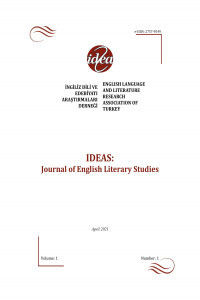Cosmopolitanism, Mobility and Hybridity in Shakespeare's Antony and Cleopatra
Cosmopolitanism, Mobility and Hybridity in Shakespeare's Antony and Cleopatra
Cosmopolitanism, Mobility, East and West, Hybridity Power struggle in Antony and Cleopatra,
___
- Alulis, Joseph.“The Tragedy of Politics: Shakespeare's Antony and Cleopatra.” Perspectives on Political Science, vol. 41, no. 4, 2012, pp. 190-194. Taylor and Francis Online, doi: 10.1080/10457097.2012.713262.
- Banerjee, Pompa. “Cosmopolitanism and ‘Strange Flesh’ in Antony and Cleopatra.” Parergon, vol. 35, no. 1, 2018, pp. 119-139. Project Muse, doi: 10.1353/pgn.2018.0006.
- Billy, Christine D. “The Renaissance Theater’s Boy Actresses.” Antony and Cleopatra: Performance History, Humanities Department, Cedar Crest College, https://www2.cedarcrest.edu/academic/eng/lfletcher/ac/cbilly.htm. Accessed 08 June 2021.
- Cohen, Walter. “Introduction to Antony and Cleopatra.” The Norton Shakespeare, edited by S. Greenblatt et al. New York: Norton. 1997, pp. 2625-2655.
- Crane, Mary Thomas. “Roman World, Egyptian Earth: Cognitive Difference and Empire in Shakespeare’s Antony and Cleopatra.” Comparative Drama, vol. 43, no. 1, 2009, pp. 1-17. Project Muse, doi: 10.1353/cdr.0.0041.
- Cunningham, Dolora G. “The Characterization of Shakespeare's Cleopatra.” Shakespeare Quarterly, vol. 6, no. 1, 1955, pp. 9-17. JSTOR, doi: 10.2307/2866047.
- De Sousa, Geraldo U. “Habitat, Race, and Culture in Antony and Cleopatra.” Shakespeare’s Cross-Cultural Encounters. Palgrave Macmillan, 1999, pp. 129-158.
- De Sousa, Geraldo U. “Boundaries in a Globalized World: Shakespeare’s Antony and Cleopatra.” Renaissance Papers 2016, edited by Jim Pearce et al., Camden House, 2017, pp. 69-78.
- Harris, Jonathan Gil. “‘Narcissus in Thy Face’: Roman Desire and the Difference It Fakes in Antony and Cleopatra.” Shakespeare Quarterly, vol. 45, no. 4, 1994, pp. 408-425. JSTOR, doi: 10.2307/2870964.
- Haug, Emily. “Local Politics in the Late Republic: Antony and Cleopatra at Patras.” American Journal of Numismatics (1989-), vol. 20, 2008, pp. 405-420.
- Hirsh, James. “Rome and Egypt in Antony and Cleopatra and in Criticism of the Play.” Antony and Cleopatra: New Critical Essays, edited by Sara Munson Deats. Routledge, 2005, pp: 175-191.
- “Hybridity.” Oxford Reference. https://www.oxfordreference.com/view/10.1093/oi/authority.20110803095952517. Accessed: 08 June 2021.
- Miller, Anthony. “Varieties of Power in ‘Antony and Cleopatra’.” Sydney Studies in English, vol. 30, 2004, pp. 42-59.
- Kalmey, Robert P. “Shakespeare’s Octavius and Elizabethan Roman History.” Studies in English Literature, 1500-1900, vol. 18, no. 2, 1978, pp. 275-287. JSTOR, doi: 10.2307/450362.
- Neill, Michael, editor. Introduction. Antony and Cleopatra, by William Shakespeare, Oxford UP, 2008, pp. 1-130.
- Ritchie, Shannon. “Securing Permanent Power: The Sexism of Self-Otherization in Shakespearean Plays.” Journal of the Wooden O., vol. 14, no. 1, 2015, pp. 43-54.
- Rose, Paul Lawrence. “The Politics of Antony and Cleopatra.” Shakespeare Quarterly, vol. 20, no. 4, 1969, pp. 379–389. JSTOR, doi: 10.2307/2868534.
- Shakespeare, William. Antony and Cleopatra, edited by Michael Neill, Oxford UP, 2008.
- Tanner, Tony. “Antony and Cleopatra: Boundaries and Excess.” Memoria di Shakespeare: A Journal of Shakespearean Studies, vol. 4, 2017, pp. 1-19. R.O.SA, doi: 10.13133/2283-8759/14466.
- Tillis, Steve. “East, West, and World Theatre.” Asian Theatre Journal, vol. 20, no. 1, 2003, pp. 71–87.
- Turner, Frederick. Shakespeare’s Twenty-First Century Economics: The Morality of Love and Money. Oxford UP, 1999.
- Wortham, Christopher. “Temperance and the End of Time: Emblematic Antony and Cleopatra.” Comparative Drama, vol. 29, no. 1, 1995, 1-37. Project Muse, doi: 10.1353/cdr.1995.0030.
- Yachnin, Paul. “Shakespeare's Politics of Loyalty: Sovereignty and Subjectivity in Antony and Cleopatra.” Studies in English Literature, 1500-1900, vol. 33, no. 2, 1993, pp. 343-363. JSTOR, doi: 10.2307/451003.
- Başlangıç: 2021
- Yayıncı: İngiliz Dili ve Edebiyatı Araştırmaları Derneği / English Language and Literature Research Association of Turkey
Magic and Collage: Language in Ginsberg’s "Wichita Vortex Sutra"
Literary Cycling and Its Importance in the Accounts of Joseph and Elizabeth Robins Pennell
Review of A Regarded Self: Caribbean Womanhood and the Ethics of Disorderly Being
Transmitted Memories in David Whitehouse's The Long Forgotten
Aurelija DAUKŠAITĖ-KOLPAKOVIENĖ
Cosmopolitanism, Mobility and Hybridity in Shakespeare's Antony and Cleopatra
